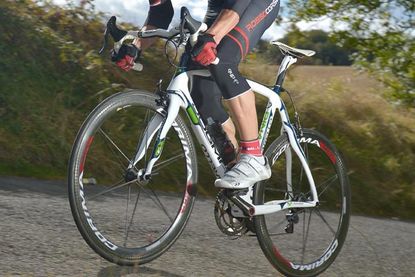Pinarello Dogma2 Campagnolo Super Record EPS review

In essence that rear mech encapsulates all you need to know about Campagnolo's take on electronic shifting. It is sleek, clever and a positive step forward in improving shift performance - especially in the long term. But above all else, it's expensive. Very, very expensive. For our money Pinarello really struck gold when it came up with the Dogma and in doing so put itself back at the front of the race bike market. The Dogma2 built on that work and we loved it even more. Here’s what we said when we tested it in March. “The Dogma2 fits into a very small group of bikes that truly make you want to attack the road. Going fast isn’t enough, you need and in fact will positively want to get out of the saddle and smash it down the road until the lactate in your legs makes you sit down again — it’s that good.”
-
+
Crisp shifting in every situation
-
+
Reduce chance of a mis-shift
-
+
Great frame with inspiring ride
-
-
Expensive
You can trust Cycling Weekly.
For many people, taking a top of the range Italian carbon frame and dressing it up with top of the range carbon components is their idea of a dream bike.
We looked at the Pinarello Dogma2 earlier this year (read the full test here>>)and were blown away by the frame's performance. So, the quality of the frame is a given but how about the other parts of the equation? It's pretty much a dead cert to say that the Dogma will pass the test of time but how about Campagnolo's Super Record EPS?
Launched for the 2012 season, Campagnolo strictly limited supplies of EPS (electronic power shift) coming into the UK - perhaps to create exclusivity, perhaps to ensure any possible problems could be fully dealt with rather than cause a cascade of issues - or perhaps it was simply a question of limited production capacity. Whatever the reason, shops were told that just 160 EPS (Record and Super Record) sets would be available but that didn't include those that came in on complete bikes like our test version.
In line with their Japanese rivals, the Italians have wisely stuck with what has already been tried and tested so the components that don't form part of the electronics package are the same as the mechanical version of Super Record (read brakes, cranks, bottom bracket, chain). Again, much like Shimano, the shifters look very similar to the mechanical version - perhaps in Campag's case even more so.
This is a wise move as it means the ergonomics of this most tactile component are a known quantity. The most obvious and important change, though, is to the down-shift button mounted on the inside of the hood; this has become elongated and lowered making it easier to operate, especially for smaller hands.
Clever stuff
While the lever throw/button travel is greater than that of Di2, the likelihood of a mis-shift is significantly less thanks to the physical click of the micro button.
The micro-click, which feels and sounds a lot like the mouse button on your home computer, adds so much to the tactility of the shift and your confidence that when riding criterium circuits I'd find myself counting the downshifts while coasting into the hairpin, then as you start to pedal out the mech places the chain in the gear you asked for and you're ready to get on the gas. In fact this kind of highlights just what makes electronic shifting so good and it's that you know the chain is correctly aligned - it always is.
You can't, but then you never need to, half-shift to help get the desired gear - in this way the electronic system really shows up the failing of even the newest, most perfectly tuned mechanical gears, let alone those that are old, worn and dirty. To ensure correct gear selection the rear mech self-trims, on the six smallest sprockets the ‘brain' over-shifts slightly, when either going up or down the block, then after a few milliseconds pulls it back. It's very clever stuff.
Just like mechanical Super Record, the front mech has multiple micro-adjusts although on EPS they are controlled by the system, so as you work your way down the block the front mech adjusts twice to keep the derailleur cage from rubbing on the chain and does the same when going up. Thanks to this functionality Campag has been able to keep the narrow front cage which in turn makes it quicker and more precise - but it certainly adds to the complexity.
As for the actual shift speed, the prospective buyer has no need to worry. It's superb with next to no delay between hitting the shift button and the shift occurring. Unlike the Japanese Di2 system, the Italians have incorporated a multi-shift option. By holding down the shift lever for more than a few milliseconds the mech will start to work its way across the cassette, I say ‘work' rather than ‘glide' because it stops at every gear on its way across. Because of this and the fact that you have to wait for it to get started, we found it was faster to just repeatedly press the button for rapid, cross-gear movement.
You get the impression that the engineers really battled with the marketing department over this option. On one side you have the need to offer continuity with multi-shifts available on top of the range mechanical so they should be included on EPS and on the other, holding the shift button means that time is actually wasted. Added to this to ensure the chain remains fully engaged, it's only ever able to shift one gear at a time, albeit without a pause between.
Having the Pinarello for a couple of months I've never felt the need to use the multi-shift function - in my opinion Campag should have simply left it out. Saying that, one of the brilliant things about electronics is that having it costs nothing in terms of weight.
Tour de force
Campagnolo has made EPS a bit of a tour de force of fancy technology with a number of eye-catching additions. You'll notice that the battery pack, which also contains the ‘brain', is a sealed unit. This means on-the-fly battery changes aren't possible and that you have to drag the bike to a power source to recharge which is a bit of a pain thanks to the bulky control unit, whereas with Shimano the battery can be removed and plugged in. To be fair, it's hardly a disaster and if it ensures a better lifespan and makes the unit less susceptible to the weather, then it can only be a good thing.
Interestingly, placing the unit in standby mode involves inserting a magnetic on/off plug - the battery will hold its charge for six months after this has been put in place.
The front and rear mechs themselves really serve to highlight the differences in electronic shifting over mechanical. While the front mech is bulky thanks to its miniature gearbox and motor sitting on top, it's also immensely powerful; the chain has no choice but to conform to the mech's will.
The same could be said of the rear mech with its titanium nitride-coated actuator; so sleek and beautifully crafted from carbon-fibre but at the same time looks fragile and vulnerable stuck out next to the rear wheel ready to be damaged by the smallest of tumbles. And at £640.99 for a replacement that could be a very expensive little spill.

Thank you for reading 20 articles this month* Join now for unlimited access
Enjoy your first month for just £1 / $1 / €1
*Read 5 free articles per month without a subscription

Join now for unlimited access
Try first month for just £1 / $1 / €1
Get The Leadout Newsletter
The latest race content, interviews, features, reviews and expert buying guides, direct to your inbox!
-
 Buy One Get One Free on bikes didn't save Kona as brand is put up for sale
Buy One Get One Free on bikes didn't save Kona as brand is put up for saleAmerican gravel and mountain bike brand will "continue to seek a buyer"
By Adam Becket Published
-
 Is the Cycle to Work scheme disadvantaging those who really need it?
Is the Cycle to Work scheme disadvantaging those who really need it?Questions have been raised about the commission providers charge local bike shops - but the scheme could be improved for users, too
By Sam Jones Published
-
 It's Commuting Week at Cycling Weekly - here's what you can expect
It's Commuting Week at Cycling Weekly - here's what you can expectJoin us as we celebrate all things riding from A to B this week
By Michelle Arthurs-Brennan Published